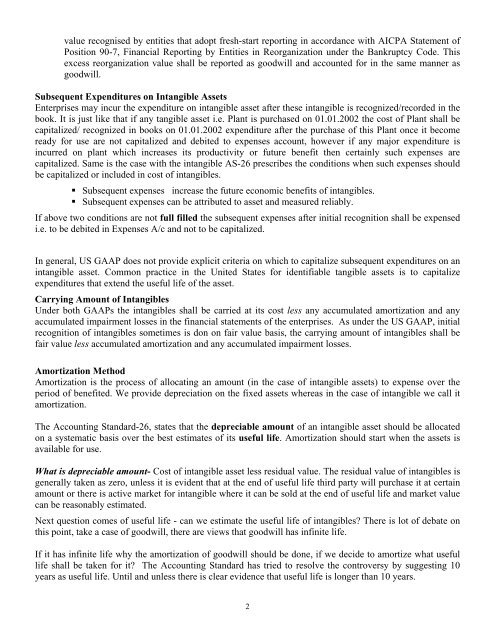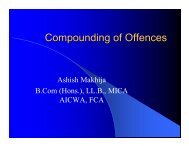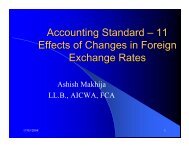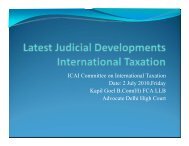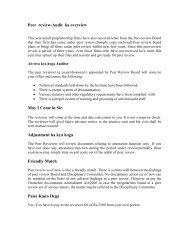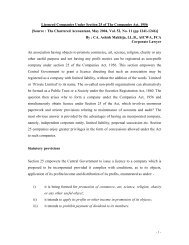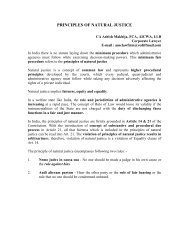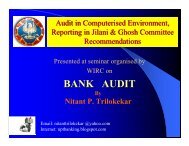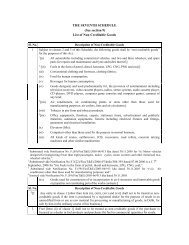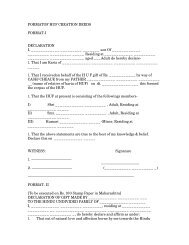dsrawat, fca intangible assets
dsrawat, fca intangible assets
dsrawat, fca intangible assets
You also want an ePaper? Increase the reach of your titles
YUMPU automatically turns print PDFs into web optimized ePapers that Google loves.
value recognised by entities that adopt fresh-start reporting in accordance with AICPA Statement ofPosition 90-7, Financial Reporting by Entities in Reorganization under the Bankruptcy Code. Thisexcess reorganization value shall be reported as goodwill and accounted for in the same manner asgoodwill.Subsequent Expenditures on Intangible AssetsEnterprises may incur the expenditure on <strong>intangible</strong> asset after these <strong>intangible</strong> is recognized/recorded in thebook. It is just like that if any tangible asset i.e. Plant is purchased on 01.01.2002 the cost of Plant shall becapitalized/ recognized in books on 01.01.2002 expenditure after the purchase of this Plant once it becomeready for use are not capitalized and debited to expenses account, however if any major expenditure isincurred on plant which increases its productivity or future benefit then certainly such expenses arecapitalized. Same is the case with the <strong>intangible</strong> AS-26 prescribes the conditions when such expenses shouldbe capitalized or included in cost of <strong>intangible</strong>s.• Subsequent expenses increase the future economic benefits of <strong>intangible</strong>s.• Subsequent expenses can be attributed to asset and measured reliably.If above two conditions are not full filled the subsequent expenses after initial recognition shall be expensedi.e. to be debited in Expenses A/c and not to be capitalized.In general, US GAAP does not provide explicit criteria on which to capitalize subsequent expenditures on an<strong>intangible</strong> asset. Common practice in the United States for identifiable tangible <strong>assets</strong> is to capitalizeexpenditures that extend the useful life of the asset.Carrying Amount of IntangiblesUnder both GAAPs the <strong>intangible</strong>s shall be carried at its cost less any accumulated amortization and anyaccumulated impairment losses in the financial statements of the enterprises. As under the US GAAP, initialrecognition of <strong>intangible</strong>s sometimes is don on fair value basis, the carrying amount of <strong>intangible</strong>s shall befair value less accumulated amortization and any accumulated impairment losses.Amortization MethodAmortization is the process of allocating an amount (in the case of <strong>intangible</strong> <strong>assets</strong>) to expense over theperiod of benefited. We provide depreciation on the fixed <strong>assets</strong> whereas in the case of <strong>intangible</strong> we call itamortization.The Accounting Standard-26, states that the depreciable amount of an <strong>intangible</strong> asset should be allocatedon a systematic basis over the best estimates of its useful life. Amortization should start when the <strong>assets</strong> isavailable for use.What is depreciable amount- Cost of <strong>intangible</strong> asset less residual value. The residual value of <strong>intangible</strong>s isgenerally taken as zero, unless it is evident that at the end of useful life third party will purchase it at certainamount or there is active market for <strong>intangible</strong> where it can be sold at the end of useful life and market valuecan be reasonably estimated.Next question comes of useful life - can we estimate the useful life of <strong>intangible</strong>s? There is lot of debate onthis point, take a case of goodwill, there are views that goodwill has infinite life.If it has infinite life why the amortization of goodwill should be done, if we decide to amortize what usefullife shall be taken for it? The Accounting Standard has tried to resolve the controversy by suggesting 10years as useful life. Until and unless there is clear evidence that useful life is longer than 10 years.2


